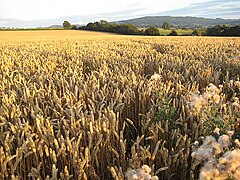Ariconium
| Ariconium | |
|---|---|

Bury Hill, approximate site of Ariconium
|
|
|
|
|
| OS grid reference | SO6423 |
| Coordinates | 51°55′N 2°31′W / 51.91°N 2.52°WCoordinates: 51°55′N 2°31′W / 51.91°N 2.52°W |
|
|
Ariconium was a road station of Roman Britain mentioned in Iter XIII of the Iter Britanniarum of the Antonine Itineraries. It was located at Bury Hill in the parish of Weston under Penyard, about 3 miles (5 km) east of Ross on Wye, Herefordshire, and about 15 miles (24 km) southeast of Hereford. The site existed prior to the Roman era, and then came under Roman control. It was abandoned, perhaps shortly after 360, but precisely when and under what circumstances is unknown.
Discovered as a result of efforts to map the stations of the Antonine Itineraries, research and excavation have provided the only information on its history, to date showing it to have been a place of bloom furnaces, forges, and iron working throughout its existence.
The Forest of Dean and nearby areas were an ancient source of iron ore and charcoal. There is evidence of early mining and smelting, and there were many sites consisting of groups of forges. The site of Ariconium was on the rise of a hill, where airflow is increased due to the terrain. This favoured the establishment of bloomeries, an ancient process that produced imperfect iron, together with cinders, dirt, and unreduced oxide. A Roman contribution was the use of bellows, causing an air blast that was hotter and produced better but unforgeable iron, requiring a further refining by reheating, and using a great deal of charcoal. The cinder refuse or scoriae was dumped in great piles at such sites.
In the early years of serious research into the locations of stations on the Antonine Itineraries, the location of Ariconium was in doubt, and William Camden (1551–1623) suggested Magnis, the site of modern Kenchester, some 7 miles (11 km) northwest of modern Hereford. Later analysis of the Antonine Itineraries, notably by John Horsley (1685–1732), refined previous estimates and ultimately placed Ariconium at Bury Hill, Weston under Penyard, 17 miles (27 km) west-northwest of Glevum (at modern Gloucester), and 13 miles (21 km) northeast of Blestium (at modern Monmouth). With confidence that the overgrown ruins near Weston under Penyard were actually the site of Ariconium, local people began clearing away the brush, revealing the enormous magnitude of the cinder piles, and further revealing the walls of buildings. Stories emerged of significant Roman-era relics, and there were unverified stories that existing relics having no provenance had actually been found in Ariconium.
...
Wikipedia

